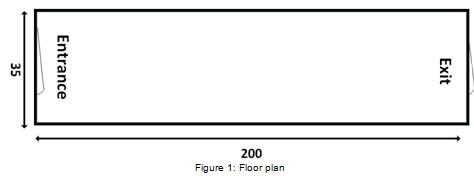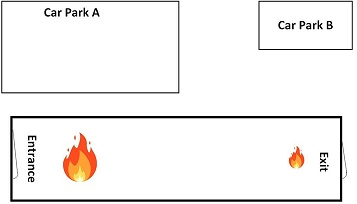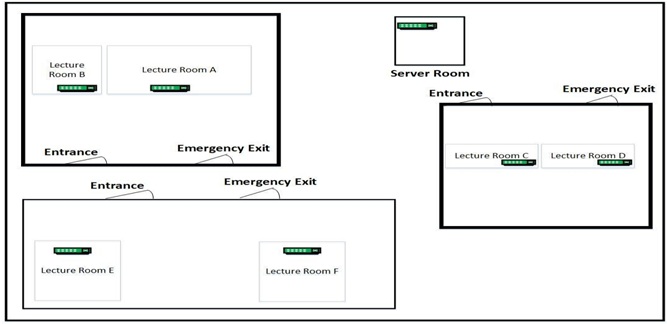Wireless Mobile and Multimedia Networking
ANONYMOUS MARKING
You have been hired to design, test and evaluate a network for a new department building at University of Hertfordshire. The scenario can be explained in four tasks.
TASK 1
Fig.1 depicts the corridor of the new building, which will require continuous WiFi connection to users. Write a python script to emulate the environment with access points. Completion of this task will require the knowledge and understanding of the lab material and will require extra knowledge that can be obtained through self-study and research.

DI524 Access Points have been purchased that provide a range of 35. You are expected to deploy a number of APs (AP1, AP2, .., APn) to provide a continuous connection. For emulation purposes, emulate 5 stations. The stations can represent a smart hand-held device which can vary from to a laptop, UE or to any WiFi compatible device.
Stations (STA1, STA2, STA3, STA4, and STA5) must carry a Class C private IP address. APs must be connected using a physical link facilitating a linear topology. Fill the rest of the table below to suit your preference that will aid in facilitate the above floor plan.
|
Name
|
MAC
|
IP Address
|
(X,Y)
coordinates
|
SSID
|
Password
|
Channel
|
|
AP1
|
|
N/A
|
|
|
studentID
|
|
|
APn
|
|
N/A
|
|
|
studentID
|
|
|
STA1
|
|
|
|
N/A
|
studentID
|
N/A
|
|
STA2
|
|
|
|
N/A
|
studentID
|
N/A
|
|
STA3
|
|
|
|
N/A
|
studentID
|
N/A
|
|
STA4
|
|
|
|
N/A
|
studentID
|
N/A
|
|
STA5
|
|
|
|
N/A
|
studentID
|
N/A
|
Table 1: MAC, IP, SSID, coordinates and other information of the nodes to be filled by the student.
Encryption type for the communication is wpa2 and the failMode is standalone. The stations must be in mobility state. Add mobility to your script. Use your preferred x and y coordinates to Entrance, and Exit.
The mobility of the station nodes will be in the following sequence.
|
Name
|
Start Location
|
End Location
|
Start Time - End Time
|
Moving Speed (min-max)
|
|
STA1
|
Entrance
|
Exit
|
10s-20s
|
min_v=1, max_v=5
|
|
STA2
|
Entrance
|
Exit
|
30s-60s
|
min_v=5, max_v=5
|
|
STA3
|
Exit
|
Entrance
|
25s-60s
|
min_v=7, max_v=7
|
|
STA4
|
Exit
|
Entrance
|
10s-20s
|
min_v=1, max_v=10
|
|
STA5
|
Exit
|
Entrance
|
15s-20s
|
min_v=5, max_v=5
|
Table 2: Mobility of the Nodes
Upon completion of the script with mobility, your network should emulate the following.
Deliverable:
• Completed Table 1 and Table 2.
• Python script that you utilized to push to configurations towards the Mininet API
• Screenshot from the Mininet WiFI GUI
o Prior Mobility
o At the completion of mobility
• Ping STA1<- - - > STA2, STA2<- - - > STA3, STA1<- - -> STA3, STA1<- - - > STA4. Provide the screenshot of your successful pings. You may use the Mininet commands line or the x-Term CLI
• Initiate a VoIP connection between the two assigned STAs.
o Throughput
o Provide the Protocols visible in the VoIP connection and elaborate their functionality on how they contribute towards the connection.
TASK 2
Fig.2 depicts the floor plan of the new building and the emergency gathering car park. During an emergency, response units will communicate via AdHoc devices. You have been assigned to evaluate which adhoc protocol ( olsr or babel) functions best. You will require a minimum of 3 devices in mobility, either from car park to the emergency exit or vice-versa. Completion of this task will require the knowledge and understanding of the lab material and will require extra knowledge that can be obtained through self-study and research.

Figure 2: Floor plan and car park
|
Name
|
IPv6
|
MAC
|
Position
|
Range
|
Antenna
Height
|
Antenna
Gain
|
Protocol
|
SSID
|
HT_CAP
|
|
adhoc1
|
|
|
|
40
|
1
|
5
|
olsr
|
adhocUoH
|
HT40+
|
|
adhoc2
|
|
|
|
40
|
2
|
6
|
olsr
|
adhocUoH
|
HT40+
|
|
adhoc3
|
|
|
|
40
|
3
|
7
|
olsr
|
adhocUoH
|
HT40+
|
|
adhoc4
|
|
|
|
30
|
3
|
7
|
olsr
|
adhocUoH
|
HT40+
|
|
adhoc5
|
|
|
|
30
|
3
|
7
|
batman
|
adhocUoH
|
HT40+
|
|
adhoc6
|
|
|
|
30
|
3
|
7
|
batman
|
adhocUoH
|
HT40+
|
Table 3: MAC, IP , SSID , coordinates and other information of the nodes for Task to be filled by the student
Your report must include the following:
• Modelling
o Brief explanation on Mininet, Adhoc networking and WIFI networking (0.5 pg)
o Explanation of the Python commands using code snippets
o Screenshots as mentioned in the deliverable section in each task
• Results
o Throughput graphs
• Analysis
o Calculate TCP Success rate for adhoc networks separately (olsr and batman).
o Critically evaluate the two adhoc protocols (olsr, batman) and present your findings. Which protocol performed better? Provide an analysis backed by references.
TASK 3
You have been hired to connect the newly built building with the old building of University of Hertfordshire. For the purpose of emulation each lecture room must have at least 1 PC. Server room must have two Servers. The three buildings and server room must be connected. Each Lecture room in must be in a separate VLAN and switches in each building must be connected using either a ring or grid topology.

Figure 4: Building plan
|
Name
|
IP Address
|
Room
|
MAC
|
VLAN
|
|
H1
|
Class B IP address/16
|
Lecture Room A
|
|
100
|
|
H2
|
Class B IP address/16
|
Lecture Room A
|
|
100
|
|
H3
|
Class B IP address/16
|
Lecture Room B
|
|
200
|
|
H4
|
Class B IP address/16
|
Lecture Room B
|
|
200
|
|
H5
|
Class B IP address/16
|
Lecture Room C
|
|
300
|
|
H6
|
Class B IP address/16
|
Lecture Room C
|
|
300
|
|
H7
|
Class B IP address/16
|
Lecture Room D
|
|
400
|
|
H8
|
Class B IP address/16
|
Lecture Room D
|
|
400
|
|
H9
|
Class B IP address/16
|
Lecture Room E
|
|
500
|
|
H10
|
Class B IP address/16
|
Lecture Room E
|
|
500
|
|
H11
|
Class B IP address/16
|
Lecture Room F
|
|
600
|
|
H12
|
Class B IP address/16
|
Lecture Room F
|
|
600
|
|
Server
|
12.0.0.1/8
|
Server Room
|
|
N/A
|
|
UDP
|
41.0.0.1/8
|
Server Room
|
|
N/A
|
Table 4: Network configurations
TASK 4
Upon successful completion of the above task, please use the video and the host assigned to you to conduct the rest of the tasks.
1. Configure a route between Server or UDP (as assigned) and the Host (as assigned to you). Provide the command you utilized at both server and client end.
2. Confirm the route functionality with a ICMP stream. Provide a screenshot of the same.
3. Initiate a UDP flow between Server/UDP and Host to total of 480 seconds using the port number assigned to you with a bandwidth of 10Mbps.
4. Use the video that have been assigned to you, host it at the assigned Server/UDP and stream it at the assigned Host.
Your report must include the following:
• Modelling
o Brief explanation on OpenFlow and SDN (0.5 page max)
o Explanation of the Python commands using code snippets
o What is a VLAN? Explain how this can be advantageous over LANs using references.
o Network metrics such as throughput, loss and jitter affect the overall performance of your network.
o Screenshots as mentioned in the deliverable section in each task
• Results
o Total jitter, delay and mean throughput of the UDP
o Throughput graph obtained from Wireshark during video stream
o Total number of Packet loss from the video stream, screenshot of the statistic file from Wireshark
• Analysis
o Evaluate the network statistics (packet loss, delay, and throughput) of UDP traffic of iPerf against the network statistics of video traffic.
o Evaluate a network based on SDN against a traditional next-hop network. Provide references.
There is a maximum of 20-page limit (A4 size) excluding appendices and references, although marginal excess can be condoned. Utilised Python Scripts must be in the Appendix section.
Report
Your report must include the following.
1. Modelling
a. A brief introduction to the environments
b. Modelling Process
c. Experiments
2. Results and Analysis
a. Task1
i. Results and Analysis
b. Task2
i. Results and Analysis
c. Task3
i. Results and Analysis
d. Task4
i. Results and Analysis
3. Conclusion
4. References
5. Appendixes